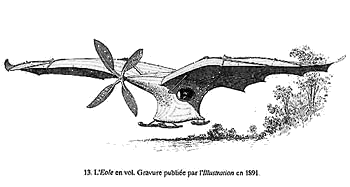|
Introduction
The nineteenth century saw the development of
two things important for flight:
the science of flying and the
personality of the flier. Mastering the former was no
mean feat. Objects hurtling
through the air are not well
behaved and don’t conform nicely to the elegant diagrams of
air flowing over an airfoil. All
sorts of forces the Bernoullis
never dreamed of can act to twist and turn
the aircraft, and once a
flier loses control and goes into a tailspin, it is very
difficult to regain control and
avoid crashing.
Beginning with George Cayley and continuing
through the Wright
brothers, a great deal of testing and
calculating was necessary—on paper and in test
devices—if a feasible flying
machine was going to be created.
But the people who were going to go up in
those aircraft also had to undergo a transformation:
they had to become fliers
(“airmen,” they called them).
People had to gain experience
riding the wind and adjusting—either
their controls or their
dangling weight—in order to maintain control of their
aircraft.
They had to be adept at
reacting to the shifts in air pressure that might affect
their aircraft. Flying an
aircraft, some understood, was not
like riding a wagon as a
passenger; it was more like riding a
temperamental horse. It
required a bond and connection
between flier, machine, and the sky itself.
Not everyone agreed with
this assessment of the role of the
pilot, and the question was one of the key issues
among the community of experimenters. The active
approach won out, but just barely. If Samuel
Langley’s machine had
succeeded in flying when it was tested just a
few days before the Wright
brothers’ landmark flight of
December 17, 1903, the future course of aviation might
have looked quite different
and the active-flier concept might
be a relic of an idea instead of a fundamental of flight
training and practice, as it has become.
If the
proper approach to flight was discussed among experimenters
and enthusiasts, the general public looked at the entire
matter differently. Centuries of disappointment had created
the impression that flight was just impossible and that
anyone involved in any research or experiment related to
flight must be a crackpot. Serious scientists or engineers
who wrote about the subject rarely said openly that they
were discussing flight—”aerial navigation” was the euphemism
they used. When Langley’s Aerodrome crashed into the Potomac
on a cold December day in 1903, the report of the War
Department, which had funded the project (and so must have
had some hope that Langley would succeed), declared that
“we are still far from the ultimate goal [of human flight].”
Five days later, the Wright brothers proved them dead wrong.

|
